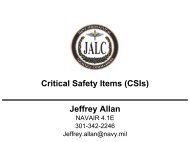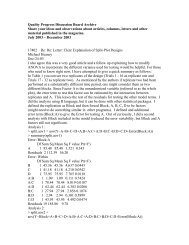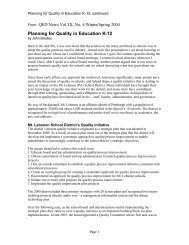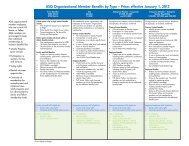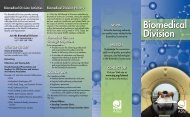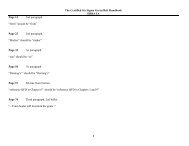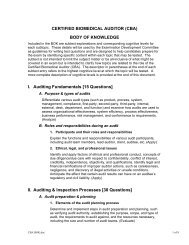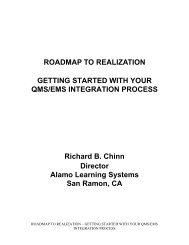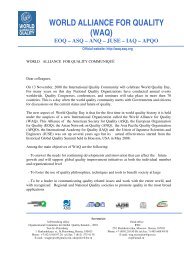Access this Content
Access this Content
Access this Content
You also want an ePaper? Increase the reach of your titles
YUMPU automatically turns print PDFs into web optimized ePapers that Google loves.
AS6081<br />
Appendix - C.1<br />
Minimum Counterfeit<br />
Part Detection Methods
AS6081<br />
Appendix - C.1.1<br />
Documentation and<br />
Packaging Inspection<br />
(100%)
Exterior<br />
Packaging<br />
Inspection
Counterfeit<br />
factory box
Interior Packaging Inspection
Barcode DOES NOT<br />
Match Human-<br />
Readable Data
OCM Document Inspection
Counterfeit<br />
C of C’s
Counterfeit<br />
Labels
3 rd Party Reels – especially small<br />
parts w/o markings
Counterfeit HID Card
AS6081<br />
Appendix - C.1.2<br />
Visual Inspection<br />
(100%)
Different Date<br />
Codes
Component Markings & Physical<br />
Condition
Datasheet Comparison
Mechanical Verification
Microscopy<br />
Microscopic Inspection<br />
Inspection
Marks from Prior use or<br />
3 rd Party Tampering
Rust Inside Terminal
Chip in Glass<br />
Capacitor
Substandard Solder Balls
Visual Evidence of<br />
Blacktopping
Blacktop in Dimple<br />
Visual Evidence<br />
of Blacktopping
Damaged Leads
AS6081<br />
Appendix - C.1.3<br />
Inspection for Evidence<br />
of Remarking or<br />
Resurfacing
AS6081<br />
Appendix - C.1.3.1<br />
Marking Permanency<br />
Test<br />
(Sampling)
Mineral Spirits/Alcohol Test
After Marking Permanency<br />
Before Marking Permanency
AS6081<br />
Appendix - C.1.3.2<br />
Surface Finish<br />
Permanency Test<br />
(Sampling)
Acetone Test
Before<br />
After
Laser-Etch Remarking Still<br />
Visible After Black-Topping<br />
Has Been Removed
Baked-On Black-Topping<br />
Scraping<br />
Required<br />
to Remove<br />
Baked-On<br />
Finish
Example of a<br />
Sandblasted<br />
Component<br />
Surface<br />
Note there are<br />
NO Sanding<br />
Marks
Dynaloy Dynasolve 750<br />
Heated<br />
Solvent<br />
Testing
Exposed Sanded Surface<br />
Counterfeit Device
Sanding Marks Clearly Evident
AS6081<br />
Appendix - C.1.4<br />
X-Ray Inspection<br />
(100%)
Exemplar<br />
Suspect<br />
Dual Screens allow for<br />
Comparative Analysis
Match Pin-Out to Datasheet
Images Taken Through Tubes
X-Ray Image Seen Through<br />
Mfg’s Tubes
Images Taken Through Sealed Bags
Components in Trays as<br />
Seen Through Sealed Bags
AS6081<br />
Appendix - C.1.5<br />
X-Ray Fluorescence<br />
(100%)
AS6081<br />
Appendix - C.1.6<br />
Decapsulation / Die<br />
Inspection<br />
(Sampling)
AS6081<br />
Appendix - C.2<br />
Additional Counterfeit<br />
Part Detection Tests
AS6081<br />
Appendix - C.2<br />
• Scanning Acoustic Microscopy<br />
• Destructive Physical Analysis<br />
• Thermal Cycle Testing<br />
• Electrical Testing<br />
• Burn-In<br />
• Hermeticity Verification
AS6081<br />
Appendix - C.2.1<br />
Scanning Acoustic<br />
Microscopy Inspection<br />
(Sampling)
Surface Image Scans<br />
for Resurfacing<br />
“Blacktop” Detection
Exemplar<br />
Suspect
Exemplar<br />
Suspect
Exemplar<br />
Suspect
Exemplar<br />
Suspect
Exemplar<br />
Suspect
Exemplar<br />
Suspect
Latent Defect Detection<br />
(on same 6 parts)<br />
• Cracks<br />
• Voiding<br />
• Delamination
Exemplar<br />
Device<br />
Internal<br />
Image Scan<br />
Suspect<br />
Device
Exemplar<br />
Device<br />
Internal<br />
Image Scan<br />
Suspect<br />
Device
Exemplar<br />
Device<br />
Internal<br />
Image Scan<br />
Suspect<br />
Device
Exemplar<br />
Device<br />
Internal<br />
Image Scan<br />
Suspect<br />
Device
Exemplar<br />
Device<br />
Internal<br />
Image Scan<br />
Suspect<br />
Device
Exemplar<br />
Device<br />
Internal<br />
Image Scan<br />
Suspect<br />
Device
Surface Layer Scan<br />
Exemplar<br />
Suspect
Surface Layer Scan<br />
Exemplar<br />
Suspect
Surface Layer Scan<br />
Exemplar<br />
Suspect
Surface Layer Scan<br />
Exemplar<br />
Suspect
Calculating Die Void %
Total % of Die Attach Void
MIL-STD-883G<br />
Method 2030<br />
“Ultrasonic Inspection”
MIL-STD-883G<br />
Method 2030<br />
“Ultrasonic Inspection”<br />
“a. Contact area voids in excess of<br />
50 percent of the total intended<br />
contact area.”
Relative Standards<br />
• MIL-STD-883G<br />
• MIL-STD-1580B<br />
•J-STD-035<br />
• NASA PEM-INST-001<br />
•ESA/SCC No. 25200
J-STD-035<br />
Provides<br />
C-SAM<br />
inspection<br />
process<br />
roadmap
MIL-STD-1580B<br />
“Acoustic Microscopy”
Dynasolve 750 Testing<br />
Purpose: To determine suitable<br />
conditions in which Dynasolve<br />
750 will consistently remove the<br />
new blacktopping from a<br />
counterfeit device while not<br />
damaging the factory top-coating<br />
on an authentic component.
Dynaloy Dynasolve 750<br />
Dynasolve 750 is used<br />
for dissolving cured<br />
urethanes, silicones,<br />
anhydride-cure epoxies<br />
and photo-resist films.
Parameters Tested<br />
Samples of similar authentic and<br />
counterfeit devices were soaked<br />
in Dynasolve 750 at 5 degree<br />
intervals between 80 – 180<br />
degrees Celsius for a maximum<br />
of one hour per temperature<br />
setting.
Conclusion<br />
Our results found that Dynasolve<br />
750 pre-heated to 105 degrees<br />
Celsius consistently removed the<br />
new blacktopping from counterfeit<br />
devices when soaked for 45<br />
minutes.<br />
When these same test conditions<br />
were performed on exemplar<br />
devices we saw no removal of the<br />
factory topcoat.
Sample ½ soaked for 45 minutes in Dynasolve<br />
750 @ 105 degrees Celsius – the new<br />
blacktopping was completely removed to expose<br />
the sanded surface<br />
Counterfeit Device
Exposed Sanded Surface<br />
Counterfeit Device
Treated Area<br />
Untreated Area
Sanding Marks Clearly Evident
Damage was caused to a known good device<br />
when ½ soaked for 45 minutes in Dynasolve 750<br />
at a temperature of 140 degrees Celsius<br />
Exemplar Device
After Dynasolve 750 Testing<br />
Sample ½ soaked for 45 minutes in Dynasolve 750 @<br />
105 degrees Celsius – No topcoat removed<br />
Exemplar Device
After Dynasolve 750 Testing<br />
Both Samples ½ soaked for 45 minutes<br />
in Dynasolve 750 @ 105 degrees Celsius<br />
Exemplar<br />
Device<br />
Counterfeit<br />
Device
This test procedure<br />
should be considered a<br />
destructive test as<br />
demonstrated by these<br />
C-SAM images.
Before Dynasolve Soak
After Dynasolve Soak



